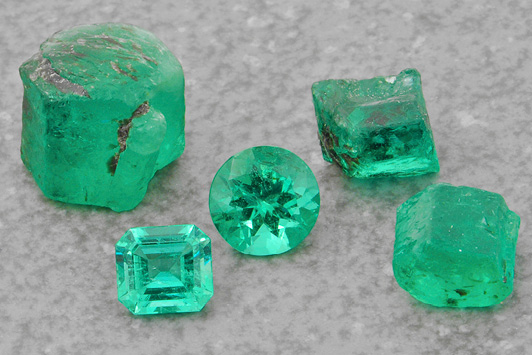
When it comes to discoveries of important gem deposits, East African countries like Kenya, Tanzania, Mozambique and Madagascar regularly make the news. But it’s only recently that Ethiopia has gained a name for itself in the gem world.
In 2010, large amounts of high-quality opal were found in the northwestern town of Wegel Tena, Wollo Province, putting Ethiopia on the map. Now the country is getting attention for emerald mining in the Seba Boru district, just north of the Kenyan border, near the town of Shakiso.
A promising resource
These emeralds created a buzz at the February gem shows in Tucson, Arizona. Market analyst Stuart Robertson of Gemworld International mentioned them in a presentation at the AGTA GemFair, name-dropping Mayer & Watt and Pillar & Stone as two leading distributors of the material in North America.
While Zambia has proven to be an important emerald source, he noted, the material from there is darker than the coveted rich greens of Colombian, which high-quality Ethiopian emerald more closely resembles. Robertson, whose company puts out the
GemGuide trade publication, believes Ethiopia is poised to be a great alternative for the emerald market in the same way Mozambique has been for ruby.
“It’s the most important emerald deposit to hit the market in 100 years,” declares Simon Watt of the Kentucky-based Mayer & Watt. Discovered in late 2016, the resource is promising, according to Watt, who raves about the intense, rich color of its stones.
Looking for clarity
The material covers a range of clarity grades and colors, from light bluish-green to a saturated pure green, according to Roland Schuessel and Naryratha Heng, owners of Pillar & Stone in Tiburon, California. Some samples are reminiscent of the electric green of Paraiba tourmalines.
While recent reports in gemological journals such as
Gems & Gemology and
InColor suggest that most of the Ethiopian material is commercial-grade, lighter in saturation, and moderately to heavily included, they acknowledge that fine gem-grade crystals of exceptional size, color and clarity are obtainable. Not only that, these crystals can produce stones that don’t require clarity enhancement — an exciting development for gem-buyers.
Schuessel and Heng concur that many Ethiopian emeralds do not require clarity enhancement. And although Robertson says only about 2% to 3% of Colombian production yields such stones, Watt says at least a third of the rough he cuts does not require oiling — a situation he hails as unprecedented.
Size-wise, the Shakiso area is reportedly producing emeralds weighing up to 10 carats when faceted, with some saying there are stones as large as 20 or 30 carats.
The cost of fame
Prices for Ethiopian emerald are about 20% to 25% below those of comparable Zambian, says Robertson, though with the resource gaining popularity, he does not expect things to stay that way. In fact, he speculates, emeralds are due for a price increase in general, as they’re the only one of the top three precious gemstones not to see one in two decades. Publicity and confusion over treatments in the late 1990s negatively impacted the emerald market, continues Robertson, but it’s now on the verge of tremendous growth.
“Producers are recognizing demand for lesser treated emeralds, and so more [gem] reports are being found in the market today [citing] levels of no treatment or minor/insignificant [treatment],” says Robertson, who believes this is restoring confidence in the sector.
The biggest impact Ethiopian emeralds will have is on the high-end market, predicts Watt, noting that he sold 60% (about 20 stones) of the unoiled material he had at the Tucson gem show.
Pride of the Oromo
Watt is working directly with the Helo emerald mine, owned and operated by the 3,000-strong Oromo tribe. One of the largest tribes in the Seba Boru district, the Oromo formed the Bu’a Obsa Association to manage the asset. Emeralds were discovered at Helo about 18 months ago, according to Aynalem Halilu, facilitator of international marketing for the site. There has been sporadic emerald mining in the area over the past decade, he notes, as it has long been known for major deposits of rare metals like gold and tantalum.
Seeking out industry help to develop the resource, Halilu found Jeff Bergman, a 48-year gem-trade veteran known for top-quality unheated rubies and sapphires, and no-oil emeralds from Madagascar. The Bangkok-based Bergman, in turn, led Halilu to second-generation emerald cutter Isaac Stern in the Thai capital. The Ethiopian parties formed a legal partnership with Stern and Bergman for cutting and marketing.
Under the contract, a significant majority of the profit goes to the Bu’a Obsa Association, explains Bergman. He underscores the mine’s 100% transparent supply chain and excellent working conditions, adding that its unoiled emeralds have received lab reports from American Gemological Laboratories (AGL), the Gemological Institute of America (GIA), the Asian Institute of Gemological Sciences (AIGS), GemResearch Swisslab (GRS), Gübelin Gem Lab, and the Swiss Foundation for the Research of Gemstones (SSEF).
‘As good as Muzo’
In a separate project, London-based gem miner Gemfields — known for marketing Mozambique rubies and Zambian emeralds — acquired an exploratory license in the area when it bought 75% of Web Gemstone Mining in February 2015.
“We have had some positive results to date,” says Emily Dungey, Gemfields’ head of public relations and communications.
Those involved with Ethiopian emerald say supply looks promising for decades to come if managed properly.
“If the area keeps producing, I think it will be as good as material coming from [the Muzo deposit in Colombia],” says Watt. “Everyone I show it to, even people from Muzo, are blown away.”
Image: Mayer & WattArticle from the Rapaport Magazine - April 2018. To subscribe click here.